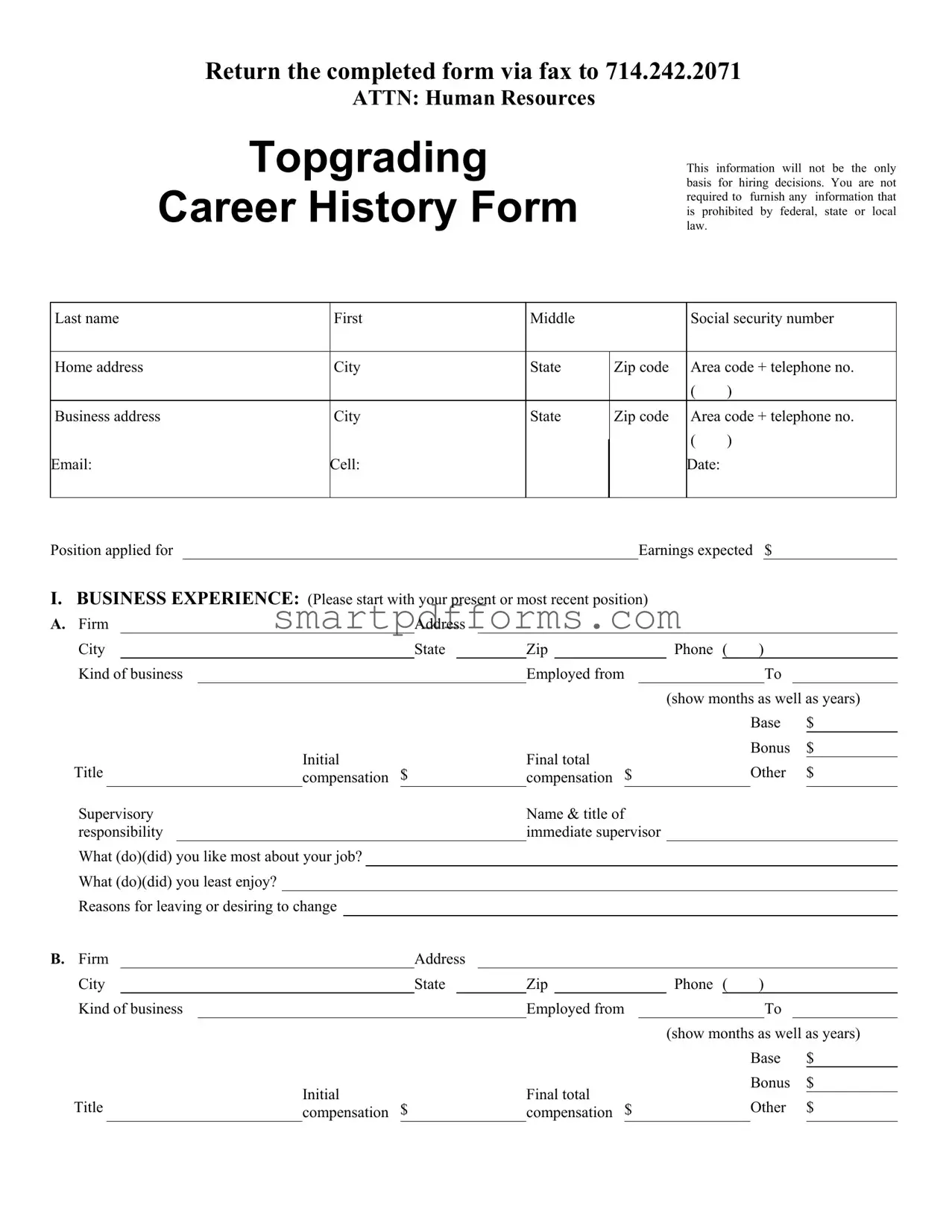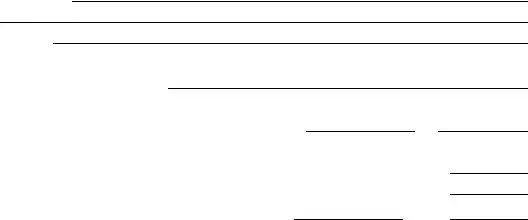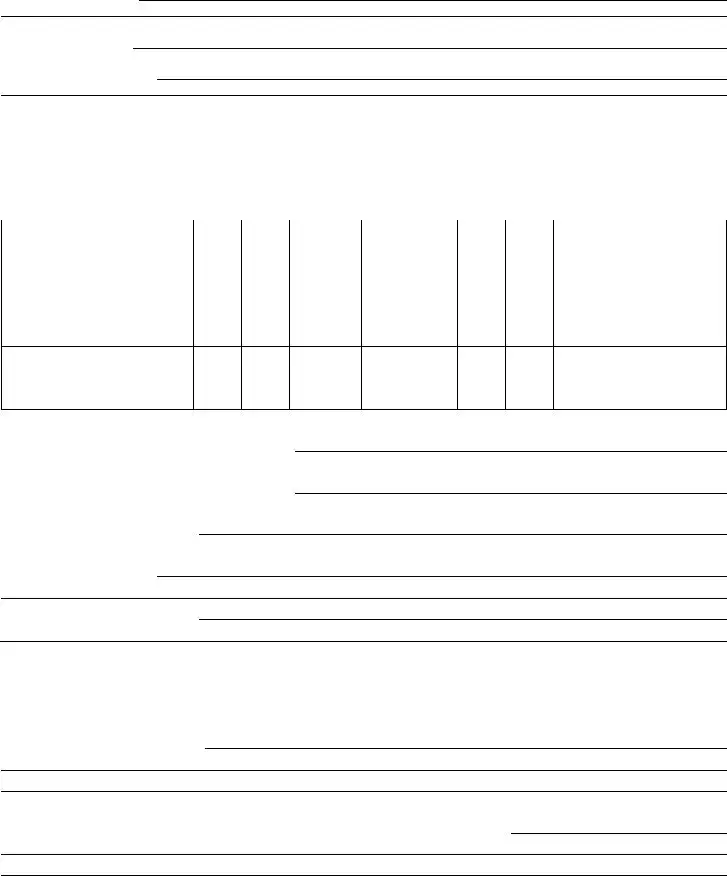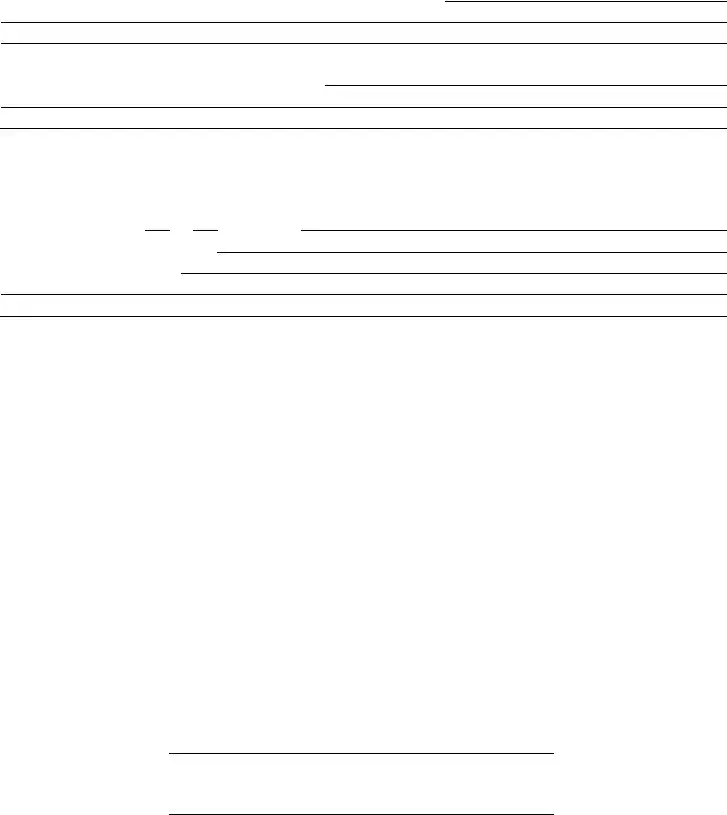Return the completed form via fax to 714.242.2071
ATTN: Human Resources
Topgrading
Career History Form
This information will not be the only basis for hiring decisions. You are not required to furnish any information that is prohibited by federal, state or local law.
Last name |
First |
Middle |
|
|
Social security number |
|
|
|
|
|
|
|
|
Home address |
City |
State |
Zip code |
Area code + telephone no. |
|
|
|
|
|
|
( |
) |
|
Business address |
City |
State |
Zip code |
Area code + telephone no. |
|
|
|
|
|
|
( |
) |
|
|
|
|
|
|
|
|
Email: |
Cell: |
|
|
|
Date: |
|
|
|
|
|
|
|
|
|
|
|
|
|
|
|
|
|
|
Position applied for |
|
|
|
|
Earnings expected $ |
|
|
|
|
|
|
|
|
|
I.BUSINESS EXPERIENCE: (Please start with your present or most recent position)
A. Firm |
|
|
|
|
Address |
|
|
|
|
|
|
|
|
|
|
|
City |
|
|
|
|
State |
|
|
Zip |
|
Phone ( |
) |
|
|
|
|
|
|
|
|
|
|
|
|
|
|
|
|
|
|
|
|
|
|
|
Kind of business |
|
|
|
|
|
|
Employed from |
|
|
|
|
To |
|
|
|
|
|
|
|
|
|
|
|
|
|
|
|
|
(show months as well as years) |
|
|
|
|
|
|
|
|
|
|
|
|
|
|
|
|
Base |
|
$ |
|
|
|
|
|
Initial |
|
|
|
Final total |
|
|
Bonus |
|
$ |
Title |
|
|
|
|
|
|
|
Other |
$ |
|
compensation $ |
|
|
|
compensation $ |
|
|
|
|
|
|
|
|
|
|
|
|
|
|
|
|
|
|
|
Supervisory |
|
|
|
|
|
|
Name & title of |
|
|
|
|
|
|
responsibility |
|
|
|
|
|
|
|
immediate supervisor |
|
|
|
|
|
|
What (do)(did) you like most about your job?
What (do)(did) you least enjoy?
Reasons for leaving or desiring to change
|
|
|
|
|
|
|
B. Firm |
|
Address |
|
|
City |
|
State |
|
Zip |
|
Kind of business |
|
|
|
Employed from |
Title |
|
Initial |
Final total |
|
compensation $ |
compensation $ |
|
|
|
|
|
To
(show months as well as years) Base $ Bonus $ Other $
Supervisory |
|
|
|
|
|
|
|
Name & title of |
|
|
|
|
|
|
responsibility |
|
|
|
|
|
|
|
|
immediate supervisor |
|
|
|
|
|
|
What did you like most about your job? |
|
|
|
|
|
|
|
|
|
|
|
|
|
What did you least enjoy? |
|
|
|
|
|
|
|
|
|
|
|
|
|
|
|
|
|
Reasons for leaving |
|
|
|
|
|
|
|
|
|
|
|
|
|
|
|
|
|
|
C. Firm |
|
|
|
|
|
Address |
|
|
|
|
|
|
|
|
|
|
|
City |
|
|
|
|
|
State |
|
Zip |
|
Phone ( |
) |
|
|
|
|
|
|
|
|
|
|
|
|
|
|
|
|
|
|
|
|
|
|
|
|
Kind of business |
|
|
|
|
|
|
|
|
Employed from |
|
|
|
|
To |
|
|
|
|
|
|
|
|
|
|
|
|
|
|
|
|
|
|
|
(show months as well as years) |
|
|
|
|
|
|
|
|
|
|
|
|
|
|
|
|
|
|
|
Base |
|
$ |
|
|
|
|
|
|
|
Initial |
|
|
|
Final total |
|
|
Bonus |
$ |
|
|
|
|
|
|
|
|
|
|
|
|
|
|
|
|
Title |
|
|
compensation $ |
|
|
|
compensation $ |
|
|
Other |
$ |
|
|
|
|
|
|
|
|
|
|
|
|
|
|
|
|
|
Supervisory |
|
|
|
|
|
|
|
Name & title of |
|
|
|
|
|
|
responsibility |
|
|
|
|
|
|
|
|
immediate supervisor |
|
|
|
|
|
|
What did you like most about your job?
What did you least enjoy?
Reasons for leaving
Other Positions held: |
|
|
|
|
|
|
|
|
|
|
|
|
|
|
|
Date (mo/yr) |
|
|
Compensation |
|
|
|
|
a. Company |
|
a. Your title |
|
a. Began |
|
|
a. Initial |
|
a. Type of work |
|
|
b. City |
|
b. Name of supervisor |
|
b. Left |
|
|
B. Final |
|
b. Reason for leaving |
D. a. |
|
|
|
|
|
$ |
|
|
|
|
|
|
|
|
|
|
|
|
|
|
b. |
|
|
|
|
|
|
|
$ |
|
|
E. a. |
|
|
|
|
|
$ |
|
|
|
|
|
|
|
|
|
|
|
|
b. |
|
|
|
|
|
|
|
$ |
|
|
F. a. |
|
|
|
|
|
$ |
|
|
|
|
|
|
|
|
|
|
|
|
b. |
|
|
|
|
|
|
|
$ |
|
|
G. a. |
|
|
|
|
|
$ |
|
|
|
|
|
|
|
|
|
|
|
|
b. |
|
|
|
|
|
$ |
|
|
|
|
|
|
|
|
|
|
|
|
|
|
|
Indicate by letter |
|
|
any of the above employers you do not wish contacted. |
II. MILITARY EXPERIENCE: |
|
|
|
|
|
|
|
|
|
|
|
|
|
If in service, indicate branch |
|
|
|
|
Date (mo/yr) entered |
|
Date (mo/yr) discharged |
Nature of duties |
|
|
|
|
|
|
|
|
|
|
|
|
|
|
|
|
|
|
|
Highest rank or grade |
|
|
|
|
|
Terminal rank or grade |
|
|
|
|
|
III. EDUCATION: |
|
|
|
|
|
|
|
|
|
|
|
|
|
|
|
|
High School 1 |
2 3 4 |
College/Graduate School 1 2 3 4 5 6 |
7 8 (Circle highest grade completed) |
A. High School |
Name of High School |
|
|
|
|
|
|
|
|
|
Location |
|
Approximate number in graduating class |
|
|
|
|
|
Rank from the top |
|
|
|
|
|
Final grade point average |
|
|
(A = |
) |
|
|
|
|
|
|
|
|
|
|
|
|
|
|
|
|
|
|
|
|
|
|
|
|
|
|
|
|
|
Extracurricular activities
Offices, honors/awards
Part-time and summer work
College/Graduate School
|
|
|
|
Grade |
Total |
Extracurricular |
|
|
|
|
point |
credit |
activities, honors |
|
|
|
|
average |
hours |
and awards |
|
Dates |
|
|
|
|
|
Name and location |
From |
To |
Degree |
Major |
|
|
|
|
|
|
(A=___) |
|
|
|
|
|
|
(A=___) |
|
|
(A=___)
What undergraduate courses did you like most? Why?
What undergraduate courses did you like least? Why?
How was your education financed?
Part-time and summer work
Other courses, seminars, or studies
IV. ACTIVITIES:
Membership in professional or job-relevant organizations (You may exclude groups that indicate race, color, religion, national origin, disability, or other protected status.)
Publications, patents, inventions, professional licenses, or additional special honors or awards
What qualifications, abilities, and strong points will help you succeed in this job?
What are your weak points and areas for improvement?
V. CAREER NEEDS:
Willing to relocate? Yes No If no, explain
Amount of overnight travel acceptable
What are your career objectives?
VI. OTHER:
Do you have the legal right to work for any employer in the United States? |
Yes |
|
No |
|
|
Have you ever been convicted of a crime (other than a minor traffic violation)? |
Yes |
|
No |
If so, explain |
|
|
|
|
|
|
|
|
|
|
|
|
|
|
|
|
|
|
|
I certify that answers given in this Topgrading Career History Form are true, accurate and complete to the best of my knowledge. I authorize investigation into all statements I have made on this Form as may be necessary for reaching an employment decision.
In the event I am employed, I understand that any false or misleading information I knowingly provided in my Career History Form or interview(s) may result in discharge and/or legal action. I understand also that if employed, I am required to abide by all rules and regulations of the employer and any special agreements reached between the employer and me.
Signature
Date
COMMUNICATION IS CRUCIAL TO SUCCESS. AS SUCH IT IS IMPORTANT THAT OUR CANDIDATES HAVE CLEAR AND CONCISE WRITING SKILLS. WE ASK THAT EVERY CANDIDATE HANDWRITE A BRIEF RESPONSE TO THIS QUESTION:
WHY ARE YOU CONSIDERING LEAVING YOUR CURRENT POSITION?




